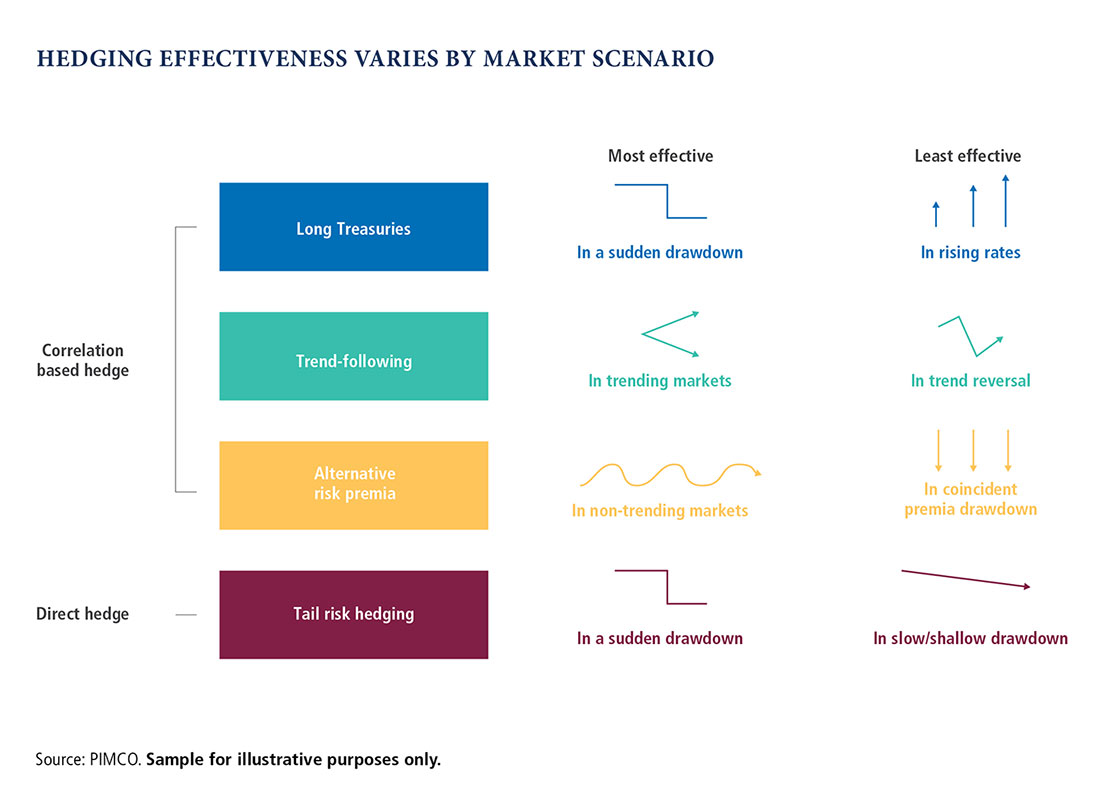Hedging for Different Market Scenarios
More investors are considering broadening their approach to diversifying equity risk to include strategies such as long duration bonds, managed futures, alternative risk premia, and tail risk hedging. However, it’s important for investors to know in what types of environments each strategy is more likely to work and in what environments each are likely to be less effective.
What this chart shows
Not every type of risk-mitigating strategy can be expected to work in every type of market sell-off.
- High quality sovereign bonds, such as long duration U.S. Treasuries, have historically been an effective hedge during flight-to-quality episodes, but can incur negative returns if interest rates rise faster than consensus expectations.
- Trend-following strategies have historically performed well in trending markets and could pair well with long duration bonds (for example, the trend-follower can reduce interest rate risk by shorting rates during a sustained sell-off in rates), but are susceptible to rapid reversals in trends.
- Alternative risk premia strategies may enhance a trend-following/long duration bonds combination further, as they have the potential to do well in non-trending markets and can act as an uncorrelated return driver. But they can be vulnerable to parallel drawdowns in multiple risk premia, however uncommon these might be.
- Tail risk hedging may offer a higher degree of reliability, albeit at the expense of short-term return potential. In contrast to the approaches above, tail risk hedging is based on contractual derivatives – not correlations, which can break. And contrary to conventional wisdom, tail risk hedges do not always have a negative expected return or a cost associated with them.
What it means for investors
There is no “silver bullet” strategy to hedge an investor’s portfolio from risk events. We believe that investors should “diversify their diversifiers” by identifying the ideal blend of correlation-based hedges and outright hedges for their unique circumstances.
Disclosures
Past performance is not a guarantee or a reliable indicator of future results. All investments contain risk and may lose value. Investing in the bond market is subject to risks, including market, interest rate, issuer, credit, inflation risk, and liquidity risk. The value of most bonds and bond strategies are impacted by changes in interest rates. Bonds and bond strategies with longer durations tend to be more sensitive and volatile than those with shorter durations; bond prices generally fall as interest rates rise, and the current low interest rate environment increases this risk. Current reductions in bond counterparty capacity may contribute to decreased market liquidity and increased price volatility. Bond investments may be worth more or less than the original cost when redeemed. Equities may decline in value due to both real and perceived general market, economic and industry conditions. Managed futures contain heightened risk, including wide price fluctuations and may not be suitable for all investors. Tail risk hedging involves entering into financial derivatives that are expected to increase in value during the occurrence of tail events. Investing in a tail event instrument could lose all or a portion of its value even in a period of severe market stress. A tail event is unpredictable; therefore, investments in instruments tied to the occurrence of a tail event are speculative. Derivatives and commodity-linked derivatives may involve certain costs and risks, such as liquidity, interest rate, market, credit, management and the risk that a position could not be closed when most advantageous. Commodity-linked derivative instruments may involve additional costs and risks such as changes in commodity index volatility or factors affecting a particular industry or commodity, such as drought, floods, weather, livestock disease, embargoes, tariffs and international economic, political and regulatory developments. Investing in derivatives could lose more than the amount invested. Swaps are a type of derivative; swaps are increasingly subject to central clearing and exchange-trading. Swaps that are not centrally cleared and exchange-traded may be less liquid than exchange-traded instruments. Diversification does not insure against loss.
The correlation of various strategies or securities against one another is based upon data over a certain time period. These correlations may vary substantially in the future or over different time periods that can result in greater volatility. Statements concerning financial market trends or portfolio strategies are based on current market conditions, which will fluctuate. There is no guarantee that these investment strategies will work under all market conditions or are suitable for all investors and each investor should evaluate their ability to invest for the long term, especially during periods of downturn in the market. Outlook and strategies are subject to change without notice.
Hypothetical and simulated examples have many inherent limitations and are generally prepared with the benefit of hindsight. There are frequently sharp differences between simulated results and the actual results. There are numerous factors related to the markets in general or the implementation of any specific investment strategy, which cannot be fully accounted for in the preparation of simulated results and all of which can adversely affect actual results. No guarantee is being made that the stated results will be achieved.
This material has been distributed for informational purposes only and should not be considered as investment advice or a recommendation of any particular security, strategy or investment product. Information contained herein has been obtained from sources believed to be reliable, but not guaranteed. No part of this material may be reproduced in any form, or referred to in any other publication, without express written permission. PIMCO is a trademark of Allianz Asset Management of America L.P. in the United States and throughout the world. ©2018, PIMCO.

